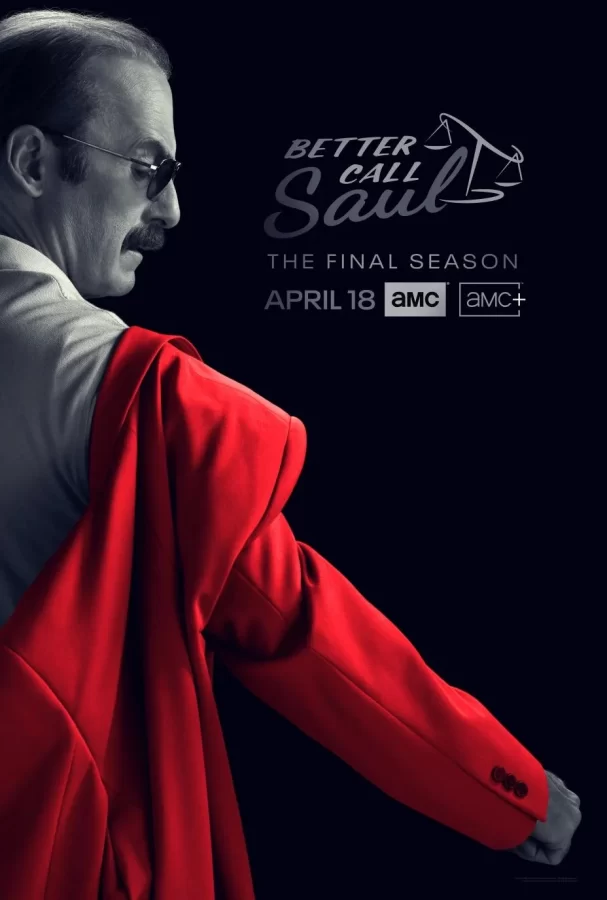“Better Call Saul: Season 6” review: Days of future past
September 12, 2022
Editor’s Note: The following review contains spoilers for the final season of “Better Call Saul.”
Whoever thought that a two-bit criminal lawyer initially utilized as comic relief would have a richly detailed and ultimately tragic backstory? Recently wrapping up its sixth and final season, “Better Call Saul” has done what perhaps no other prequel or spinoff could do: it has significantly changed the mythology around its parent show “Breaking Bad,” while also making itself its more compelling counterpart.
Released in two parts, the sixth season sees its principal players race to the end game, either before or beyond the “Breaking Bad” timeline. Public defender Jimmy McGill (Bob Odenkirk) has fully embraced his persona as criminal lawyer Saul Goodman. Together, with his wife and fellow lawyer Kim Wexler (Rhea Seehorn), they plan to ruin the career of Kim’s former boss, Howard Hamlin (Patrick Fabian).
On the cartel side, businessman Gus Fring (Giancarlo Esposito) strives to catch his nemesis Lalo Salamanca (Tony Dalton), who narrowly survived an assassination attempt last season. Caught in the crossfire is cartel lieutenant Nacho Varga (Michael Mando), who finds himself on the run: both from Fring’s men who want to silence him for his involvement in the attempt, and the Salamancas out for his blood.
But that’s not all. The series devotes its final stretch towards Jimmy hiding from the law after the events of “Breaking Bad” as Cinnabon employee Gene Takovic in Omaha, Nebraska. He becomes restless with his quiet anonymity in a literally black and white world, and later seeks to atone for his past transgressions, for better and for worse.
After seasons of patient buildup, “Better Call Saul” skillfully combines together the two worlds that Jimmy straddles: the legal and the criminal. The first half of the season is mostly devoted to he and Kim’s shenanigans in outing Howard as a drug addict. There’s a mixed feeling of joy and dread in seeing these partners-in-crime work together. On one hand, Jimmy’s antics make the viewers nostalgic for earlier seasons when it was all just a matter of relatively simple con jobs. On the other hand, it’s only a matter of time before the reason for Kim’s glaring absence in “Breaking Bad” becomes imminent. It comes to a screeching halt in the mid-season finale “Plan and Execution” when their efforts to destroy Howard become violently complicated by Lalo’s unexpected return to their home.
From there, the show acts as a requiem for itself as it steadily wraps up everyone’s storylines. This is where every actor involved ramps up their already magnetic performances into new heights. In particular, Seehorn effortlessly sells Kim’s transformation from Jimmy’s steady rock into an unlikely accomplice wracked with raw guilt. What’s even more achingly delightful is Odenkirk’s ability to channel a tragic figure more than ever in this particular season, as Jimmy’s two worlds have collided beyond repair. Jimmy and Kim have become bad for each other, and as the latter says in the episode “Fun and Games”: “Together we’re poison.” Something’s gotta give for Jimmy to become the two-bit criminal lawyer that Walter White (Bryan Cranston) eventually meets, and it’s a fate worse than death.
In a masterstroke of storytelling in television, show creators Vince Gilligan and Peter Gould devote the last four episodes to Jimmy’s life as “Gene” in Omaha. After all the violence, both physical and emotional, a monochromatic vision of the world after “Breaking Bad” envelops the show. Sure, it’s a challenge for modern viewers used to color, but it effectively underscores Jimmy’s nostalgia for the “good ole’ days.” It also shows how Kim’s life becomes equally miserable, as she settles into a normal routine working for a sprinkler company in Florida and living with her new boyfriend, who simply does not compare to Jimmy.
It soon becomes clear that after all that, Jimmy and Kim deserve each other. The entire show revolves around the strength of their relationship. As it brilliantly weaves in events from “Breaking Bad,” which drastically redefines the latter show’s narrative, it also finds ways to find closure for the couple. “Better Call Saul” may deliver a somber finale compared to its parent show, but it looks toward bittersweet hope for the tragic figure behind it all. And that’s as perfect as an ending can be.
“Better Call Saul: Season 6” is now available on Netflix.









